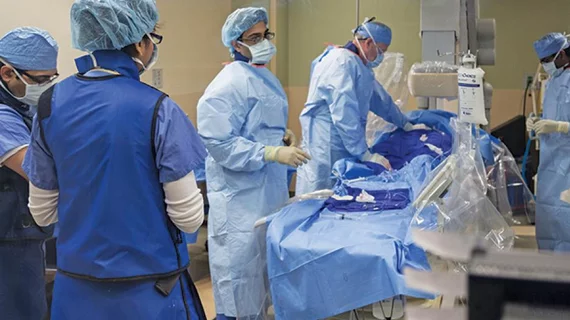Complete revascularization tops culprit-only PCI for long-term survival after NSTEMI
For patients with non-ST-segment elevation myocardial infarction (NSTEMI) and multivessel disease, complete revascularization is associated with greater in-hospital mortality but better long-term survival, according to an observational study published Oct. 15 in the Journal of the American College of Cardiology.
Complete revascularization versus culprit-lesion only revascularization for STEMI patients has been linked to lower rates of unplanned repeat interventions, all-cause mortality and repeat infarction. However, the study’s authors said the benefits of full revascularization in NSTEMI patients are less clear, and the European and U.S. guidelines don’t specify whether culprit-only or complete revascularization should be performed in these patients.
A group of British researchers led by Krishnaraj S. Rathod, MD, studied 21,857 NSTEMI patients with multivessel disease who underwent percutaneous coronary intervention (PCI) at eight London heart attack centers between 2005 and 2015. About 54 percent of those individuals underwent single-stage complete revascularization, which was associated with higher rates of in-hospital mortality (2.3 percent) than culprit-only PCI (1.5 percent).
However, at a median follow-up of 4.6 years, all-cause mortality rates were lower in the complete revascularization group (22.5 percent versus 25.9 percent), with a multivariate analysis revealing a 10 percent relative risk reduction associated with that strategy.
The researchers also balanced patient characteristics between groups using propensity score matching, which yielded 9,900 individuals in each group. In that analysis, there was still an 11 percent reduction in all-cause mortality associated with complete revascularization.
“In NSTEMI patients with MVD, single-stage complete coronary revascularization appears to be superior to culprit-only vessel PCI in terms of long-term mortality rates,” Rathod et al. concluded. “This observation needs to be validated with a larger randomized controlled trial that is powered to hard clinical endpoints.”
The higher risk and “more complex nature” of the patients requiring complete revascularization could explain the greater in-hospital mortality in that group, the authors said.
They suggested the divergence in mortality over the long term could be related to the more difficult task of identifying the culprit lesion in NSTEMI patients versus STEMI patients. With this in mind, performing full revascularization for NSTEMI may better ensure that the actual culprit vessel is treated, the authors wrote.
A landmark analysis revealed that from six months to five years post-procedure, the relative reduction in all-cause mortality associated with full revascularization was 35 percent—which explains how that technique eventually eclipsed culprit-only PCI for long-term survival.
“The landmark analysis … is an additional important contribution of this study, because it justifies the slightly higher short-term in-hospital risk of CR (complete revascularization),” Ehtisham Mahmud, MD, and Ori Ben-Yehuda, MD—both with the University of California, San Diego—wrote in a related editorial. “Increasingly, it is becoming clear that for patients with multivessel CAD, PCI outcomes are comparable to CABG only when CR is achieved.”
The editorialists noted the study was limited by its nonrandomized, retrospective nature, which introduces a likelihood of selection bias, but nevertheless said it was an “important and well-performed analysis.” Rathod and colleagues said another limitation is that contemporary practice and equipment has changed since the early stages of the study in 2005, so the use of new imaging modalities, physiologic lesion assessment techniques and drug-eluting stent technologies should be factored into future studies on this topic.
Mahmud and Ben-Yehuda said other remaining questions still need to be addressed for this patient population, including whether complete revascularization should be performed all at once or in a staged fashion; what the optimal revascularization window is; whether specific subgroups would benefit most from complete revascularization; and if physiological assessment through fractional flow reserve or instantaneous wave-free ratio can help identify which lesions require revascularization.
“Two decades after the TIMI-18 trial showed that an early invasive approach with revascularization was superior to a conservative approach in (acute coronary syndromes), we are finally moving to an era in which we will address the equally important question of the optimal revascularization approach,” they wrote. “Although physician judgment will always play a paramount role in ensuring patient safety and optimal patient selection for CR during NSTEMI, completing the job of multivessel PCI where feasible appears justified.”

